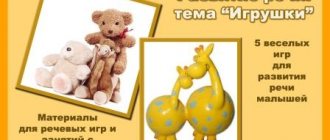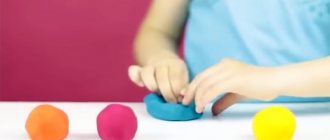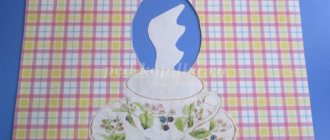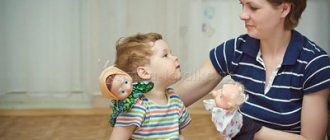Games for developing speaking skills
The basis for such games is ordinary speech. The child gains useful experience of fluent and grammatically correct spoken language. Games are useful for stimulating positive emotions if a child has isolated himself, withdrawn, or become offended.
"Skilled rhymers." It is useful to turn to such a game when you are offended by a peer, brother or sister.
Make up, make up, make up and don’t fight anymore, and if you fight, you’ll be left without a friend.
* Hey, hand, shake, shake, just don’t fight anymore.
* Relax your hand, relax and don’t pinch anymore.
* Oh, my hand is stuck! I let go of my hand and grab him by the body. You call it good, I let go of my hand.
Playful rhymes to help you overcome feelings of resentment.
Take away the insult - you are forgotten anyway,
Run into the yard, climb over the fence,
Get on your horse and ride away from me!
Book material for classes
The main features of a good book for a 2-3 year old child:
High quality illustrations.
High-quality images attract the child and do not move his attention beyond the boundaries of the picture. In high-quality publications, the drawings are usually bright, clear, “spacious” (on a light background, for better visual perception of the child), realistic, images of the characters’ bodies are proportional
High-quality illustrations develop the baby’s aesthetic taste. Communication with a book for a child is the first acquaintance with the world of art.
Conciseness of the text.
At 2-3 years old, children cannot yet listen to long fairy tales, so short rhythmic works (poems, songs, ditties, counting rhymes, riddles) and short stories and fairy tales are the best choice for children.
List of books for young children:
1. Russian folk tales (“Turnip”, “Teremok”, “Kolobok”, “Ryaba Hen”). Promotes the development of logical thinking. For example, in the fairy tale “Turnip”, the child remembers the characters in the order in which the heroes pulled the turnip - an excellent exercise for developing memory and logic.
2. Poems. Popular authors:
- A. Barto (collection “Toys”);
- K. Chukovsky (“Fairy Tales”);
- S. Marshak (“Poems and Fairy Tales”);
- lively, lively and humorous collections of poems by I. Tokmakova “Where the Fish Sleeps”, “The Sun Walks in a Circle”;
- unusual, with non-standard rhymes, poems by G. Sapgir “Wonder Forests”;
- S. Mikhalkov (“The Most Favorite Fairy Tales and Poems for Kids”) is known for his ability to tell children about their mischief and disobedience in a light, humorous manner.
3. Fairy tales of Russian authors - V. Suteev, “Fairy tales and pictures” (with the author’s own illustrations).
4. Fairy tales of foreign writers. A prominent representative is D. Donaldson. The most famous works are the fairy tale “The Gruffalo” (about a little mouse who was able to outwit the terrible monster Gruffalo), “The Gruffalo’s Little Daughter” (the book clearly traces a useful idea - you should not go far without asking your parents, it can be dangerous).
5. Educational books - help children learn to draw, glue, and sculpt.
Development of a child's grammatical abilities
These games help develop children's grammatical abilities without cramming the letters of the alphabet, without the dull reading of syllables from a book.
"Let's remember the letters." Goal: to help the child remember the letters of the alphabet, relying on auditory, visual, and muscle memory.
* An adult traces the letter along the outline, naming it, and the child shades the letter with a pencil or paints it over.
* The adult draws the outlines of the intended letter in the air, the child tries to guess and name it. In a similar way, an adult draws a letter on the child’s back.
* The letter is molded from plasticine, constructed from matches, counting sticks, and seeds.
* An adult and a child take turns naming the similarity of a letter with objects from the surrounding world.
"Hide and seek with letters." Goal: to train intelligence, imagination, and the ability to recognize familiar letters in graphic contours.
A simple pattern is drawn on a sheet of paper, on sand, on asphalt. You need to look closely at it, see the outlines of letters in its lines and show them in the pattern along the contour one by one.
Nimble fingers
The development of fine motor skills of preschoolers is facilitated by various exercises in which the fingers perform small movements:
- lacing;
- collecting pyramids, mosaics, puzzles, children's Lego;
- screwing the lids;
- sorting through cereals;
- tying shoelaces;
- fastening buttons, buttons;
- closing latches, bolts, hooks;
- drawing;
- modeling, etc.
Advice
Never start speech development classes (or any other classes) with a child if he is sick or simply doesn’t feel well, hasn’t gotten enough sleep, or is irritated. There will be no sense from such exercises anyway, but an aversion to them may appear.
In addition to these exciting activities for the baby, there are also special exercises for the dexterity of children’s hands - finger gymnastics.
You can play with a preschooler, for example, like this.
- "Sunflower". The child's palms are folded into a bud. Now the sun rises, and the sunflower blooms (palms open), turns towards it. When the sun sets, the flower also falls asleep (the palms return to their original position).
- "Pussy paws." Imitation of the movement in which a cat releases its claws. Place your fists on the table, and then open both palms, pressing your fingers to the table. Further, the exercise can be complicated by “releasing the claws” one at a time: one handle is in a fist, the second is unclenched. The first one unclenches, the second one returns to the cam.
- "Hedgehog". Place your hands on the table in front of you, interlace your fingers and move your straight fingers (“hedgehog spines”).
- "Balloons". The fingers are gathered together, the palms touching at the top, like a house. “The ball is inflated” - you need to gradually round your hands, as if there is an inflated ball in them. “The ball has burst” - return the handles to their original position.
- "Bird's watering hole." The hand is bent at the elbow, resting on the table, fingers gathered in a “pinch” - this is the head of a bird. The “bird” should bend down, pick up some water with its “beak”, and drink (move its “beak”).
- "Flying Dove" You need to cross your arms in front of you, palms facing you, fingers together. The thumbs need to be intertwined - this will be the head of a dove. Palms are wings. We flap our “wings” - the dove flies.
The child will play such games with great desire if they are accompanied by appropriate quatrains or simply interesting text.
Advice
Don't forget that young children are explorers and fidgets. It is difficult for them to concentrate on one thing for a long time. Therefore, any activities (even play) should not tire the baby: a few minutes 2-3 times a day will be quite enough for the development of a preschooler’s speech. In this case, sometimes the baby doesn’t even have to sit motionless in front of you: let him spin, run, crawl, do whatever he likes. This way the child has a stronger feeling that he is being played with, rather than being “taught.”
Fun ABC lesson
This group of games helps children learn a lot of new things from the life of words, expand their vocabulary, and knowledge about language.
Ball game "Say the opposite."
Winter summer. Heat - cold. True False. Rich man - poor man. Bitter - sweet. Useful - harmful...
"The Magic Wand of the Fairy Slovarina"
To play you need a “magic” wand. One end of the stick decreases, and the other increases.
An adult player names a word, then touches one of the children with a stick. The child calls this word either diminutive or increasing, depending on the end of the stick with which the child was touched.
House - house - house. Bridge - bridge - bridge. Rain - rain - rain. Cat - cat - cat...
Author: Krugovykh Margarita Aleksandrovna
Senior teacher of MADOU d/s No. 7 in Ishim
Everyone knows what an important function breathing performs in the life of the human body. In addition to its main physiological function - gas exchange - breathing also provides such a function as speech breathing. Speech breathing (diaphragmatic) is the basis of sounding speech, the source of the formation of sounds and voices.
The mechanism of this type of breathing is inherent in us from the very beginning. This is the oldest type of breathing, inherent in all warm-blooded animals and 90% of the total need for breathing is carried out due to it.
The main muscle that powers this type of breathing is the diaphragm . It separates the abdominal and thoracic cavities. When you inhale, the diaphragm relaxes and, falling, presses on the abdominal organs, which in turn are pressed against the abdominal wall, causing it to protrude and round. As you exhale, the diaphragm contracts, compresses the lungs, and the abdominal wall retracts. In this case, the upper part of the chest remains motionless. Outwardly, it looks like belly breathing.
When correcting speech disorders, there is a need to specially organize and develop speech breathing; breathing exercises become of particular importance. The corresponding gymnastics is aimed at developing in children the skills of correct rational breathing and voluntary control of the process of air flow movement.
We develop our hearing, learn to imitate sounds
These skills are aimed at developing phonemic awareness - the ability to hear and distinguish different sounds in speech. If phonemic hearing is not developed, the child will inevitably confuse sounds, first in pronunciation, and then in writing. This means that good phonemic hearing is one of the integral factors in the proper development of a child’s speech and good performance in school.
So, in a playful way, we carry out the following exercises with the baby.
- What does it sound like? Hide behind a screen (curtain) objects that the child has already heard in life. For example, glass glasses, metal spoons, wooden kitchen spatulas, a spray bottle for indoor flowers, etc. Take turns making these items sound. The child’s task is not to make a mistake when guessing what sounded when. If an error occurs, take out the objects that caused difficulty and show clearly what sounds they make. You can complicate the game by picking up objects unfamiliar to the child. Then first they show him what it sounds like, and then they hide it and play.
- Who is screaming? You will need an audio recording with the voices of different animals and birds (better than those that the child is already familiar with). His task is to guess every animal and bird by its voice.
- What kind of transport? The same thing, only with recordings of the sounds of different vehicles (plane, car, tractor, train, steamship).
- Where does the sound come from? The child is blindfolded. At the same time, the adult makes some sound (claps his hands, rings a bell) to the right, left, behind, in front, further or closer. The baby’s task is to point with his hand in the direction where the sound is coming from.
Onomatopoeia is another means of developing hearing and speaking, since it allows you to analyze the sound that needs to be reproduced, using the speech apparatus in its pronunciation. You can imitate a variety of sounds:
- person (moan, delight, rocking a baby, expression of pleasant taste);
- animals (frog, mosquito, elephant, beetle, dog, fly, cat, cow, etc.);
- nature (rustling leaves, thunder, wind, rain);
- household items (hammer, watch, scissors, drill, vacuum cleaner, water tap).
How to get a child to talk: effective methods for developing speech in children 2-3 years old
The most common method of developing a baby's speech that parents use is a technique called “tell mommy.” Yes, indeed, this method is beneficial, but it is far from the only one. This technique is suitable for very young children who have just begun to pronounce their first sounds. But, if this method encourages the baby to simply imitate and unconsciously repeat after the parents, then the following techniques will help the child pronounce words meaningfully and understand what is being said.
Let's explore things together
If you want to develop your child’s speech skills, try to expressively describe everything he does. At the age of one year, children begin to actively explore the world around them. They touch objects, open and close doors, touch everything with handles.
Make it a rule to describe his actions. For example, when opening and closing doors, say: “Open the door, close it.” If the child picks up an object, describe it. For example, if a child took a spoon, you can say: “Look, you have a spoon in your hands. This is a spoon"
Encourage any activity of the baby and focus on what he is doing
Getting to know the pictures
There are a lot of educational books with colorful pictures that can help a child get to know the world. Buy your child books for the little ones, for example, from the section about animals called “Who Am I?” When showing a drawing of a cat in a book or on a card, you can say: “What does a cat do? “Meow.” Through these activities, you can introduce your baby to animals and help him pronounce certain sounds. This method is ideal for a baby, since he already understands that each animal has a particular sound. Try to study animals that you can see on the street. When a child sees a dog or cat, he will begin to say “woof” or “meow.”
Education through sound
Whatever your child does, try to indicate his actions with a certain sound. For example, if he claps, say “clap-clap,” even if he fell, don’t immediately run to pick up the baby and ooh and ahh at the same time, but rather say “boom, boom.” This approach even amuses children and they quickly forget that they just flopped. This method will help the baby realize that every movement has a certain sound, and his memory will actively develop.
Speech accompaniment
When your baby makes any sounds, ask him to repeat them. For example, tell your child, “How do geese make it? “Ga-ha-ha.” If he says something that you think is absurd, like “agu, booboo,” repeat after him. The child should be encouraged to speak, pronounce any sound and be encouraged to do so.
Symptoms of speech delay at 5 years
Parents can identify disorders of a child’s speech development by the following signs:
- Strangers do not understand him, his speech is slurred and blurred.
- The vocabulary is clearly smaller than that of peers.
- Short phrases, no adjectives or adverbs.
- Difficulties with pronunciation - a large number of sounds are distorted or dropped out.
It is easy for parents to check their child’s speech using simple tests:
- Ask what a person or object is doing (mom is washing the dishes, the car is driving, the plane is flying).
- Ask them to choose antonyms for verbs or adjectives.
- Check if the child knows the colors, shapes, and baby animals.
- Ask to use a word in a different gender (the son came, and the daughter came, red ball, red cap, red dress).
If a child has 2 obvious deviations or more, the help of a speech therapist will be required.










